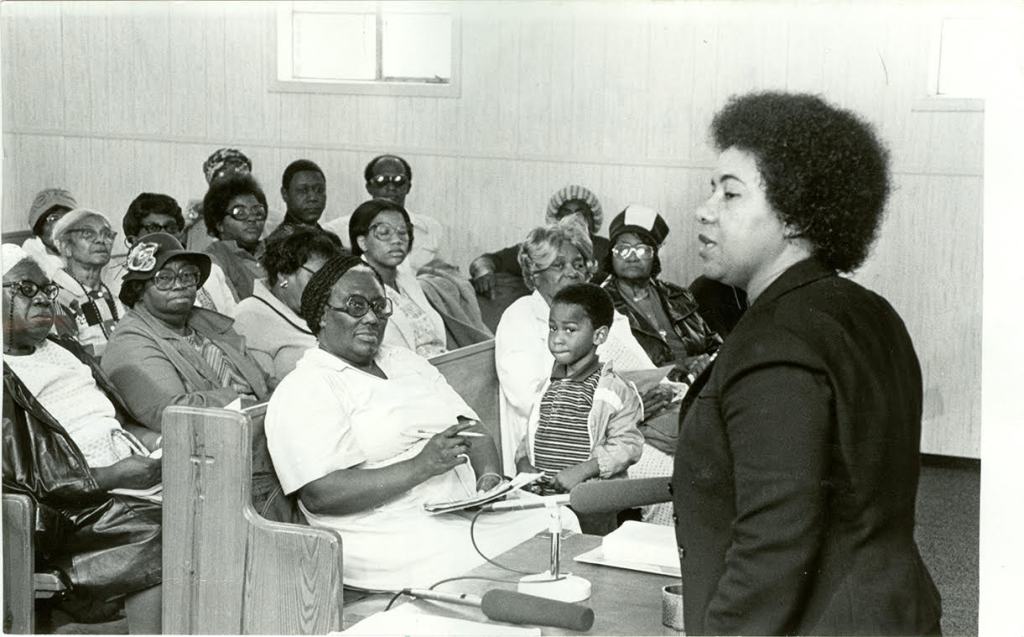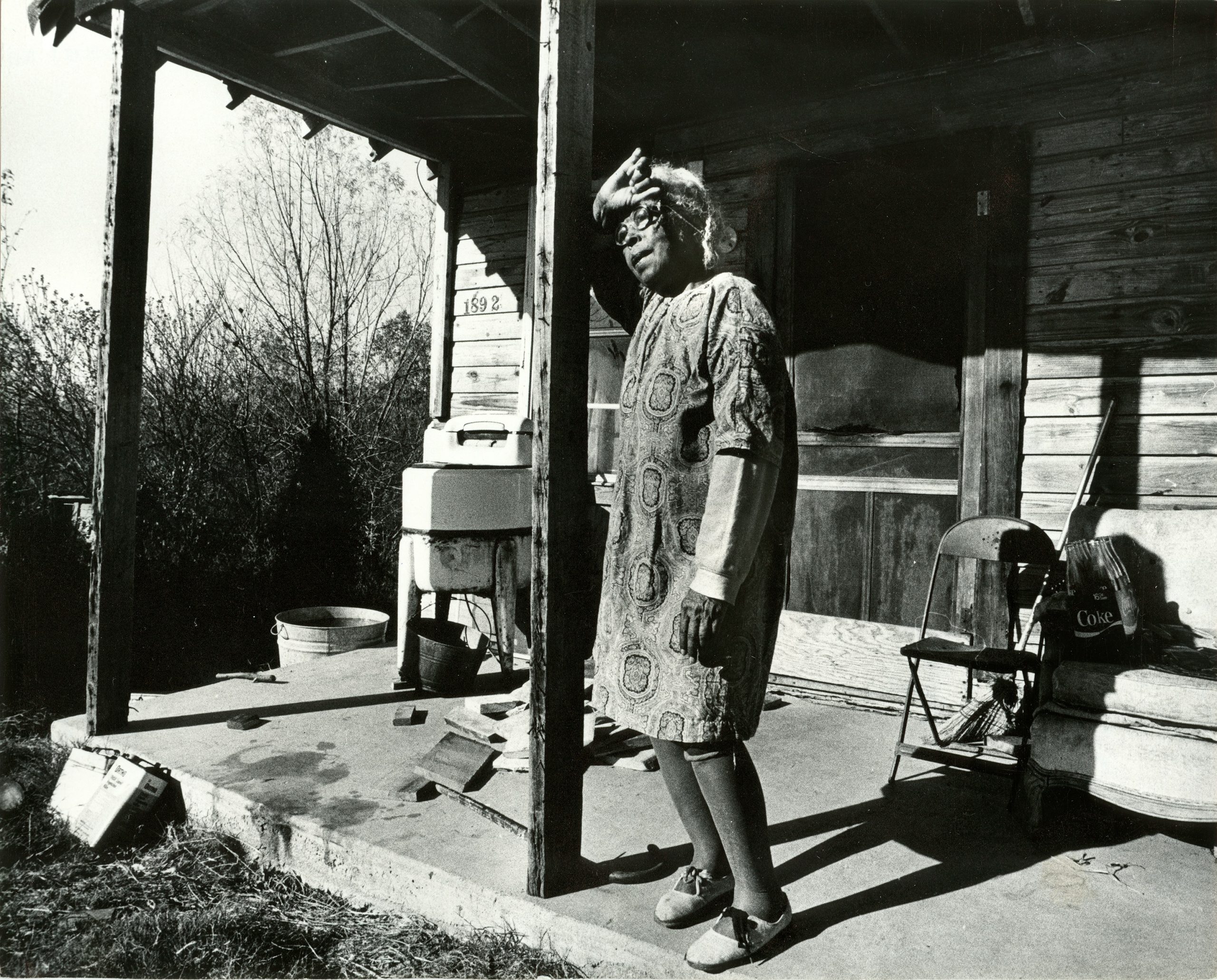FORGOTTEN NEIGHBORHOODS
By Aubrey Ford, Phoebe Weinman & Walker Weinman
Mrs. Alma Adams, 76, was still going without indoor plumbing. She had to walk through shoulder-high weeds to fetch drinking water from neighbors’ back yard taps. Her and her neighbors caught rainwater in barrels to wash their clothes. Few roads in the neighborhood had street lights, which made fetching water at night even more difficult.
This was not a neighborhood profile of Depression era 1930s Memphis. It was a follow-up report by the Memphis Press-Scimitar on the long-neglected neighborhood of Boxtown.
The story was written in 1979.
FORGOTTEN
The story of Boxtown is one of those lesser-known Memphis tales from our past. The neighborhood has a long, ambivalent relationship with Memphis. The city’s forgotten promises to the neighborhood of Boxtown can help us see that the tide of redevelopment does not necessarily raise all ships.
Boxtown abuts T.O. Fuller State Park to the south and east. To get there from downtown, you drive south on Florida Street until it becomes New Horn Lake Road, then take a right on Mitchell (before you hit Raines Road, a major thoroughfare through the better-known Westwood neighborhood).
Boxtown began as a community of emancipated slaves and freedmen shortly after the signing of the Emancipation Proclamation in 1863, and it existed as part of Shelby County, on the edge of Memphis city limits, until the early 1960s.
At that time, Boxtown looked more like a frontier village than a twentieth-century suburb. In 1979, the Memphis Press-Scimitar estimated that 52 percent of Boxtown households made under $3,000 a year. Most roads were dirt. Houses lacked indoor plumbing, water, and electricity. No public transportation connected Boxtown to the rest of Memphis. The post office did not deliver mail to individual homes.
How Boxtown Got Its Name
From The Commercial Appeal, 1993, by Ann Meeks
During the 1920s, Illinois Central experienced the biggest growth in the company’s history; and part of their expansion included their switching facility south of the Memphis city limits, known as Nonconnah Yards. The site included the Railways Ice Plant, the railroad shop and facilities for the manufacture of boxcars.
It was customary of the railroad employees to dump the timbers and planks there that were used to hold machinery in place during transit. This wood, along with other packing materials and scraps from the manufacture of the boxcars were gathered and used to build shanties just below the railroad yards, and the area became known as Boxtown.
ANNEXATION
But in 1960, the city proposed to annex Boxtown as part of a 2000-acre urban renewal program spearheaded by the Memphis Housing Authority. The plan claimed that in exchange for paying city taxes, the 5,800 neighborhood residents would receive regular city services, including fire and police services, sewer lines and street lights, signs for streets and speed regulation signs. In addition, the city would condemn houses in the area that failed to meet building codes, such as those without plumbing, and redevelopment funds would help pay for modern housing.
The Memphis Housing Authority believed the plan would benefit both residents of Boxtown and the industrial developments cropping up around it, such as a new $123 million power plant on the river and the new refineries to the north. The annexation would bring those plants into the city’s taxable area, and the African American community of the area would offer a stable labor force.
The annexation of Boxtown took place in two phases, in 1968 and 1971. Residents began paying taxes and were counted in the city’s census. Memphis Light, Gas, and Water began laying mainlines for sewer and water in 1967.
And yet as late as 1975, the promised services never arrived. Water, sewer, and electricity never made it to many of the Boxtown homes. The neighborhood faced official neglect.

Image courtesy of the University of Memphis Press-Scimitar Archives.
In the late 1970s, as Memphis planned to annex wealthier suburbs to the east such as Cordova and Countrywood, the Memphis Press-Scimitar began publishing a series of articles about Boxtown and the perils of annexation, which drew attention from city, state, and local officials.
County Commissioner Pete Sisson called Boxtown “a throwback to the Depression ‘30s” and Commissioner Minerva Johnican criticized the city for Boxtown’s widespread illiteracy, poverty, and lack of social services. Referring to the city’s new annexation plans for the east, she said, “These areas should not be annexed until Boxtown is taken care of.”

Image courtesy of the University of Memphis Press-Scimitar Archives.
MORE PROMISES
Johnican planned to join Memphis and Shelby County Legal Services Association Inc., led by future-mayor A.C. Wharton, to help organize the residents of Boxtown and insure their legal rights. In 1975, a class action suit filed in federal court charged the city with failing to provide services to the area. In 1976, the city promised $3.7 million in improvements over the following three years, so the residents dropped the lawsuit.
During the follow-up visit by the Press-Scimitar in 1979, the paper spoke to 76-year-old Alma Adams. Despite the city’s promises, her and her neighbors were still without indoor plumbing, having to catch rainwater in barrels. “We pay our taxes. We have electricity,” Mrs. Adams said. “I have a phone. We can’t understand why we can’t get water.”
November 5, 1979. Mrs. Alma Adams (left), a Boxtown resident, has no running water despite having a washing machine on her front porch. Mrs. Adams, 76, and her next-door neighbor, Mrs. Pearl Nixon, 83 (right), have to trudge through shoulder high weeds to access fresh water. Images courtesy of the University of Memphis Press-Scimitar Archives.
At the urging of Reverend T.C. McCray and U.S. Representative Harold Ford, Secretary of the Department of Housing and Urban Development Moon Landrieu toured Boxtown in April, 1980. He declared that the area had great needs and he would lobby for federal funds, but upgrades would be difficult due to the widely scattered residents.
Curiously, his response seemed to romanticize the poverty of the neighborhood. After touring the home of Redditt Butler – who had lived in his house for 37 years and had never had electricity or running water – he said, “I can’t tell you how refreshing it is to get in a neighborhood where you have had roots so long and are trying to better it.”

Image courtesy of the University of Memphis Press-Scimitar Archives.
In September of 1980, U.S. Representative Harold Ford pledged a 90 to 120-day project of priority for Boxtown residents, which would bring federal funding to the neighborhood’s development. But three years later, in 1983, Boxtown residents continued to cite the continued lack of services. Poor streets and inadequate bus services plagued the neighborhood. A street was skipped during the city’s installment of gas lines, which left dozens of houses out of the improvements.
The city and federal representatives eventually secured $12 million in federal funds from HUD for urban development. County Health and Public Service Director Peggy Edminston and other officials publicly declared their intention to help Memphis’s poorest neighborhoods. And yet the city allocated only $1.7 million to Boxtown. Officials claimed that the area entailed a “special project” that required extra attention, so the money was used to develop other near-by areas for residential usage.
Today, Boxtown is still one of the city’s poorest, and more isolated communities. Though the homes now have basic services like indoor plumbing and gas, the neighborhood streets are riddled with potholes, and most lack sidewalks. As the city abandoned Boxtown so did many residents, with blighted houses and empty businesses increasingly taking over. City neglect has been part of Boxtown’s history since before its annexation.
Authors Aubrey Ford, Phoebe Weinman, Walker Weinman are recent graduates of the University of Memphis.
Special thanks to Dr. Gerald Chaudron and Brigitte Billeaudeaux of the Special Collections Department of the UofM Libraries for their permissions and assistance with the archival photographs.
CODA
In a 1996 CA story on Tennessee State Rep. Rufus Jones, Mr. Jones described the neighborhood he grew up in as a place where his parents taught him independence, where life was the stuff of earnest work, where his parents, S. L. and Ida Jones, raised five children and prospered in the grocery business.
Jones’s father, S. L., the CA story read, was a door-to-door peddler of vegetables and fruits before opening his first grocery in 1938 at Sewanee Rd & Fields Rd in Boxtown. His father, who died in 1991, acquired the land for the store by agreeing to plant and gather the crops one year for the landowner.
After opening the Boxtown store in 1938 and expanding it several times, the Joneses opened a second store on Mitchell near Rochester in 1967 after Rufus and S. L. Jones formed a partnership. The partnership added a supermarket under the Big Star name at 893 E. McLemore in 1968. Rufus Jones sold the supermarket in 1992.

In maps: Where is Boxtown?
ABOUT THIS SERIES
Inspired by the confluence of the course material and the city’s bicentennial, this story is part of UofM English professor Donal Harris’ “Writing Like A Camera” course that asked University of Memphis Department of English students to share a story about Memphis and its history that, in their estimate, more Memphians should know. With the assistance of generous librarians, students dug through several archives of historical photographs, newspaper clippings, and other ephemera at the University of Memphis Special Collections, in McWerther Library, to inspire and piece together their projects. Read more in Mr. Harris’ full introduction to “Writing Like a Camera” here.







